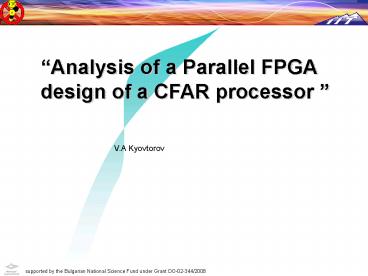Analysis of a Parallel FPGA design of a CFAR processor
1 / 16
Title:
Analysis of a Parallel FPGA design of a CFAR processor
Description:
Parallel FPGA design of a CFAR.... A typical detection process. time,s ... In this design, using two separate (smaller) FPGA chip for a 18th parallel CFAR ... –
Number of Views:193
Avg rating:3.0/5.0
Title: Analysis of a Parallel FPGA design of a CFAR processor
1
Analysis of a Parallel FPGA design of a CFAR
processor
V.A Kyovtorov
supported by the Bulgarian National Science Fund
under Grant DO-02-344/2008
2
Parallel FPGA design of a CFAR.
A typical detection process
Detection Decision Making
Square Law detector
Decimation and filtering
A/D convertion
correlator
CFAR
frequency band of 500MHz a sampling rate of at
least 1Gsps
16bit -gt system throughput 16Gbis/s.
2/16
3
Parallel FPGA design of a CFAR.
The problem
The contemporary radar and communication signal
processing requirements pose very high
computational performance demands for the real
time signal processing. For example, a
contemporary input signal frequency band of
500MHz needs a sampling rate of at least 1Gsps
or, if we assume 16bit data samples, the system
throughput reaches 16Gbis/s. Solutions
buffering fast computational units efficient
parallel structures
The purpose of this work is to propose a
performance efficient reconfigurable hardware
CFAR structure, to study the possibilities to
parallelise the CFAR algorithm and to reveal the
dependences between the algorithm
parallelisation, power consumption and the
speedup.
3/16
4
Constant False Alarm Ratio Algorithm
Parallel FPGA design of a CFAR.
xz
CA-CFAR algorithm
4/16
5
Proposed Parallelization
Parallel FPGA design of a CFAR.
Two parallel CA-CFAR computational structure
An example of two parallel CA-CFAR sliding
windows
K- sliding CFARs working in parallel
5/16
6
Applied to the signal
Parallel FPGA design of a CFAR.
6/16
7
Parallel FPGA design of a CFAR.
Hardware Data Structure
7/16
8
Parallel FPGA design of a CFAR.
Main Technology
- TECHNOLOGY
- VIRTEX II PRO, 60MHz Clock
- Tested devices XC2VP2-7fg256
XC2VP30-7ff1152 XC2VP70- 7ff1517 - Xilinx ISE
- Modelsim
- MATLAB
- Xilinx XPower Analyzer
- Altera Stratix II
- Quartus II 9.0
- XPower Analyser/ PowerPlay Power Analyzer
8/16
9
Parallel FPGA design of a CFAR.
Experimental Results
Data Input 16bit
algorithm verification procedure
9/16
10
Parallel FPGA design of a CFAR.
Experimental Results
The throughput eq. for 16 bit data input
f is the maximal frequency according to the
Xilinx ISE synthesis tool, k-the number of
parallel CA-CFAR structures
The maximal throughput for XC2VP30, XC2VP70 and
XC2VP2, acc. to Xilinx ISE tool
10/16
11
Parallel FPGA design of a CFAR.
Utilization, acc. to Xilinx ISE tool
11/16
12
Parallel FPGA design of a CFAR.
Utilization, acc. to Altera Quartus 9.0
12/16
13
Parallel FPGA design of a CFAR.
Total Power Estimation
Clock frequency 60Mhz
- Altera response, Stratix II technology
- Default toggle rate I/O signals 50
- Remaining signals vectorless estimation
Total power consumption for XC2VP2, XC2VP70 and
XC2VP30 as a function of k
Increasing the number of parallel structures
leads to increased number of buffers and
interconnects. The signals fanout dramatically
increases after a certain point, which costs
extra power.
13/16
14
Parallel FPGA design of a CFAR.
Some frequency reports
- Maximal reported frequency
- Virtex II Pro 60MHz
- Virtex IV 100MHz
- Stratix II 164MHz
- Stratix III gt 164MHz
14/16
15
Parallel FPGA design of a CFAR.
Conclusions
- The design utilization is linear as a function of
the k- number parallel structures and is
identical for the tested devices from the
considered VIRTEX II PRO technology. - The throughput grows linearly with the number of
parallel CFAR units. - A single CFAR implementation utilizes 1.4 of the
VIRTEX II Pro XC2VP30 chip, providing a
throughput of 974 Mbps. - 32 parallel CA-CFARs provides 37.5 utilization
and throughput 31Gbps for the same XC2VP30 chip. - k - full parallelised algorithm, k -linear
utilization and speedup has been demonstrated. - In this design, using two separate (smaller) FPGA
chip for a 18th parallel CFAR implementation
could be more efficient than a single larger one. - Xilinx Virtex Technolgy - After 18 parallel
CA-CFARs (k18) the dynamic power consumption
increases dramatically - above 750. - The signals fanout dramatically increases after a
certain point, which costs extra power. - Considering the particular implemented algorithm,
Altera Technology reveals better dynamic power
consumption and frequency possibilities than
Xilinx Virtex Technolgy
15/16
16
Parallel FPGA design of a CFAR.
Remarks and future research
Black box - Xilinx ISE / Quartus II 9.0 -XPower
Analyser/ PowerPlay Power Analyzer
Acknowledgements Gratitude to Georgi Gaydadjiev,
Georgi Kuzmanov, Pavel Zaykov, Chunyang Gou, Yao
Wang, Catalin Ciobanu, Laiq Hasan, for the help
and the constructive discussions
16/16































